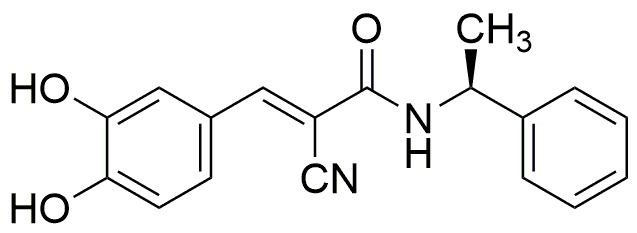Tyrphostin AG 835 is widely utilized in research focused on:
- Cancer Research: It acts as a selective inhibitor of certain receptor tyrosine kinases, making it valuable in studying cancer cell proliferation and survival mechanisms.
- Neuroscience: This compound is used to investigate the role of growth factor signaling in neuronal survival and differentiation, aiding in the understanding of neurodegenerative diseases.
- Drug Development: As a lead compound, it serves as a template for designing new therapeutic agents targeting specific kinases, enhancing the efficiency of drug discovery processes.
- Cell Biology: Researchers employ it to dissect signaling pathways in various cell types, providing insights into cellular responses to growth factors and hormones.
- Pharmaceutical Formulations: Its properties allow for the development of targeted therapies, improving treatment outcomes in conditions like diabetes and cancer by modulating specific signaling pathways.
General Information
Properties
Safety and Regulations
Applications
Tyrphostin AG 835 is widely utilized in research focused on:
- Cancer Research: It acts as a selective inhibitor of certain receptor tyrosine kinases, making it valuable in studying cancer cell proliferation and survival mechanisms.
- Neuroscience: This compound is used to investigate the role of growth factor signaling in neuronal survival and differentiation, aiding in the understanding of neurodegenerative diseases.
- Drug Development: As a lead compound, it serves as a template for designing new therapeutic agents targeting specific kinases, enhancing the efficiency of drug discovery processes.
- Cell Biology: Researchers employ it to dissect signaling pathways in various cell types, providing insights into cellular responses to growth factors and hormones.
- Pharmaceutical Formulations: Its properties allow for the development of targeted therapies, improving treatment outcomes in conditions like diabetes and cancer by modulating specific signaling pathways.
Documents
Safety Data Sheets (SDS)
The SDS provides comprehensive safety information on handling, storage, and disposal of the product.
Product Specification (PS)
The PS provides a comprehensive breakdown of the product’s properties, including chemical composition, physical state, purity, and storage requirements. It also details acceptable quality ranges and the product's intended applications.
Certificates of Analysis (COA)
Search for Certificates of Analysis (COA) by entering the products Lot Number. Lot and Batch Numbers can be found on a product’s label following the words ‘Lot’ or ‘Batch’.
Numéro de catalogue
Numéro de lot/série
Certificates Of Origin (COO)
This COO confirms the country where the product was manufactured, and also details the materials and components used in it and whether it is derived from natural, synthetic, or other specific sources. This certificate may be required for customs, trade, and regulatory compliance.
Numéro de catalogue
Numéro de lot/série
Safety Data Sheets (SDS)
The SDS provides comprehensive safety information on handling, storage, and disposal of the product.
DownloadProduct Specification (PS)
The PS provides a comprehensive breakdown of the product’s properties, including chemical composition, physical state, purity, and storage requirements. It also details acceptable quality ranges and the product's intended applications.
DownloadCertificates of Analysis (COA)
Search for Certificates of Analysis (COA) by entering the products Lot Number. Lot and Batch Numbers can be found on a product’s label following the words ‘Lot’ or ‘Batch’.
Numéro de catalogue
Numéro de lot/série
Certificates Of Origin (COO)
This COO confirms the country where the product was manufactured, and also details the materials and components used in it and whether it is derived from natural, synthetic, or other specific sources. This certificate may be required for customs, trade, and regulatory compliance.

